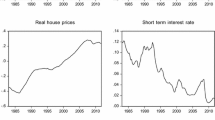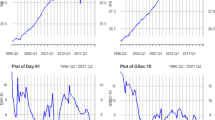Abstract
The paper assesses the stability and predictive performance of a European money demand function as compared to national money demand functions. With respect to the explanatory accuracy, the national functions perform better than the aggregated function. Examination of the residuals of the national money demand equations indicates that currency substitution is not the major cause for the stability of the aggregated money demand function. The aggregate relation mainly seems to reflect German money demand. This conclusion is supported by the instability of aggregated money demand resulting from the exclusion of Germany from the aggregate.
Similar content being viewed by others
References
Angeloni, I., C. Cottarelli, and A. Levy (1994) “Cross-Border Deposits, Aggregation, and Money Demand in the Transition to EMU.” Journal of Policy Modeling 16, 27–54.
Artis, M.J., R.C. Bladen-Hovell, and W. Zhang (1993) “A European Money Demand Function.” In P.R. Masson and M.P. Taylor (eds.), Policy Issues in the Operation of Currency Unions. Cambridge, pp. 240–265.
Barker, T. and M.H. Pesaran (1990) Disaggregation in Econometric Modeling. New York.
Bayoumi, T.A. and P.B. Kenen (1993) “How Useful is an EC-wide Monetary Aggregate as an Inter-mediate Target for Europe.” Review of International Economics 1, 209–220.
Boughton, J.M. (1991) “Long-Run Money Demand in Large Industrial Countries.” International Mon-etary Fund Staff Papers 38, 1–32.
Campbell, J.Y. and R.J. Shiller (1987) “Cointegration and Tests of Present Value Models.” Journal of Political Economy 95, 1062–1088.
Deaton, A. and J. Muellbauer (1989) Economics and Consumer Behavior. Cambridge.
Deutsche Bundesbank (1995) “Geldnachfrage und Whrungssubstitution in Europa.” Monats-Berichte 1, 33–49.
Dolado, J.J., T. Jenkinson, and S. Sosvilla-Rivero (1990) “Cointegration and Unit Roots.” Journal of Economic Surveys 4, 249–273.
Edwards, J.B. and G.H. Orcutt (1969) “Should Aggregation Prior to Estimation Be the Rule?.” The Review of Economics and Statistics, 409–420.
Falk, M. and N. Funke (1995) “The Stability of Money Demand in Germany and the EMS: Impact of German Unification.” Weltwirtschaftliches Archiv 131, 470–488.
Funke, N. (1995) Nominale Anker als geldpolitische Koordinationsziele.Tübingen.
Giucca, P. and A. Levy (1992) “Monetary Aggregates and Monetary Policy Coordination on the Way to Economic and Monetary Union: the Role of Cross-Border Deposits.” Temi di Discussione, Banca d'Italia.
Goodhart, C. (1990) “International Financial Linkages.” Special Paper No. 21, LSE Financial Markets Group, Special Paper Series, London School of Economics.
Gorman, W.M. (1953) “Community Preference Fields.” Econometrica 21, 63–80.
Granger, C.W.J. (1990) “Aggregation of Time-Series Variables: A Survey.” In T. Barker and M. Hashem Pesaran (eds.), Disaggregation in Econometric Modeling. New York, pp. 17–34.
Grunfeld, Y. and Z. Griliches (1960) “Is Aggregation Necessarily Bad?.” The Review of Economics and Statistics 42, 1–13.
Gulde, A.M. and M. Schulze-Ghattas (1992) “Aggregation of Economic Indicators Across Countries: Exchange Rate versus PPP Based GDP Weights.” International Monetary Fund Working Paper, WP/92/36.
Hansen, H. and K. Juselius (1995) CATS in RATS: Cointegration Analysis of Time Series. Evanston (Illinois).
Henry, J. and J. Weidmann (1995) “Asymmetry in the European Monetary System Revisited: Evidence from the Causality Analysis of Daily Eurorates.” Annales d'Economie et de Statistique 40, 125–160.
Herrmann, H., H.-E. Reimers, and K.-H. T ödter (1994) “Weighted Monetary Aggregates for Ger-many.” Deutsche Bundesbank Discussion Paper, Frankfurt am Main.
Hoffman, D.L., R.H. Rasche, and M.A. Tieslau (1995) “The Stability of Long-Run Money Demand in Five Industrial Countries.” Journal of Monetary Economics 35, 317–339.
Johansen, S. (1988) “Statistical Analysis of Cointegration Vectors.” Journal of Economic Dynamics and Control 12, 231–254.
Kremers, J.J.M. and T.D. Lane (1990) “Economic and Monetary Integration and the Aggregate Demand for Money in the EMS.” International Monetary Fund Staff Papers 37, 777–805.
Laidler, D.E.W. (1993) The Demand for Money: Theories, Evidence and Problems. New York.
Lane, T.D. and S.S. Poloz (1992) “Currency Substitution and Cross-Border Monetary Aggregation: Evidence from the G-7.” International Monetary Fund Working Paper, WP/92/81.
Lee, K.C., M.H. Pesaran, and R.G. Pierse (1990) “Testing for Aggregation Bias in Linear Models.” The Economic Journal 100, 137–150.
Monticelli, C. and M. Strauss-Kahn (1991) “European Integration and the Demand for Broad Money.” Notes d' ´ etudes et de recherche, Banque de France.
Monticelli, C. and L. Papi (1996) European Integration, Monetary Co-ordination, and the Demand for Money. Oxford.
OECD (1990) Purchasing Power Parities and Real Expenditures-GK Results. Paris.
Pesaran, M.H., R.G. Pierse, and M.S. Kumar (1989) “Econometric Analysis of Aggregation in the Context of Linear Prediction Models.” Econometrica 57, 861–888.
Rasche, R.H. (1994) “Money Demand and the Term Structure: Some New Ideas on an Old Problem. ” Paper Presented at the Konstanz Seminar on Monetary Theory and Monetary Policy, May 24–27.
Theil, H. (1954) Linear Aggregation of Economic Relations. Amsterdam.
Van Riet (1993) “Studies of EC Money Demand: Survey and Assessment.” De Nederlandsche Bank, Quarterly Bulletin 1992/4, 63–75.
Author information
Authors and Affiliations
Rights and permissions
About this article
Cite this article
Wesche, K. The Stability of European Money Demand: An Investigation of M3H. Open Economies Review 8, 371–391 (1997). https://doi.org/10.1023/A:1008243130051
Issue Date:
DOI: https://doi.org/10.1023/A:1008243130051




